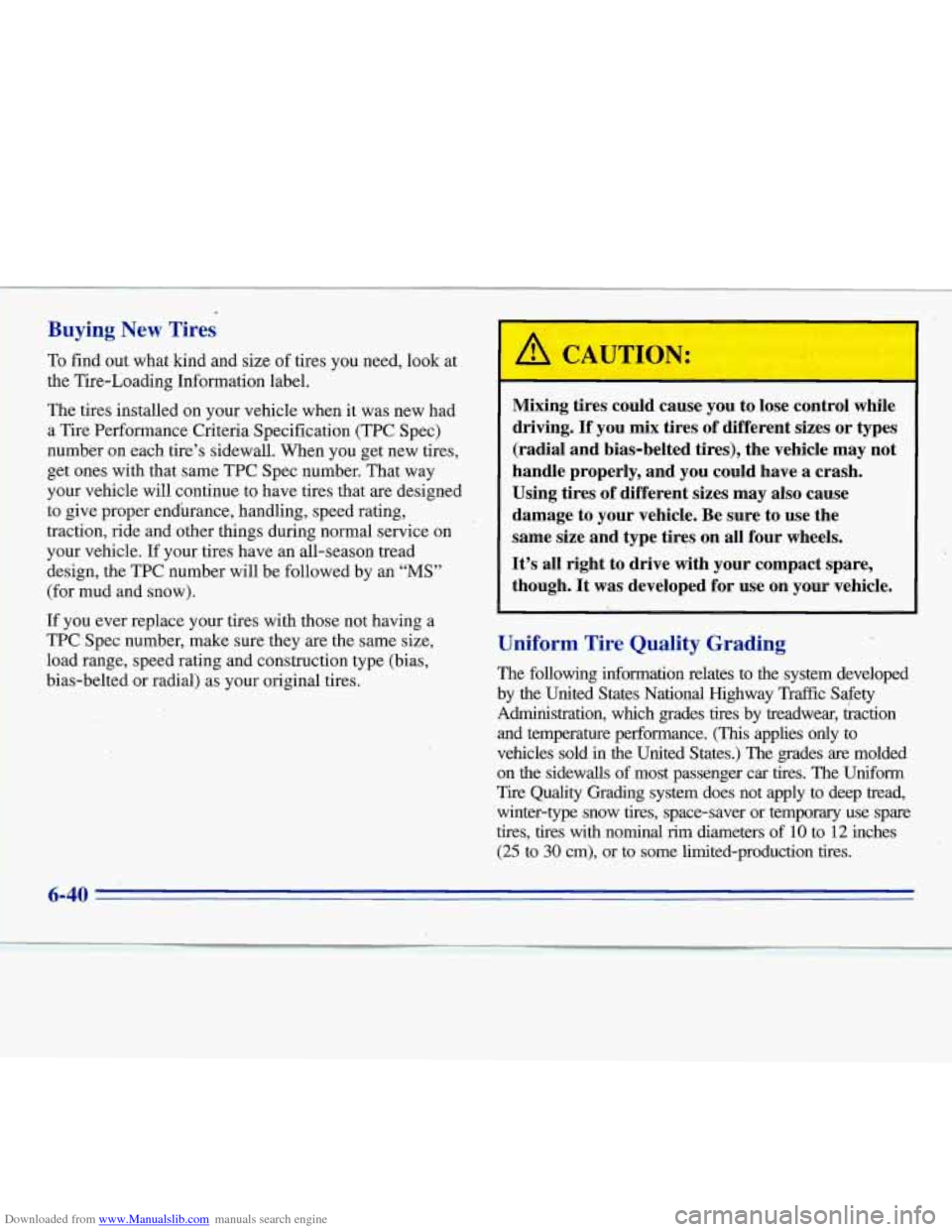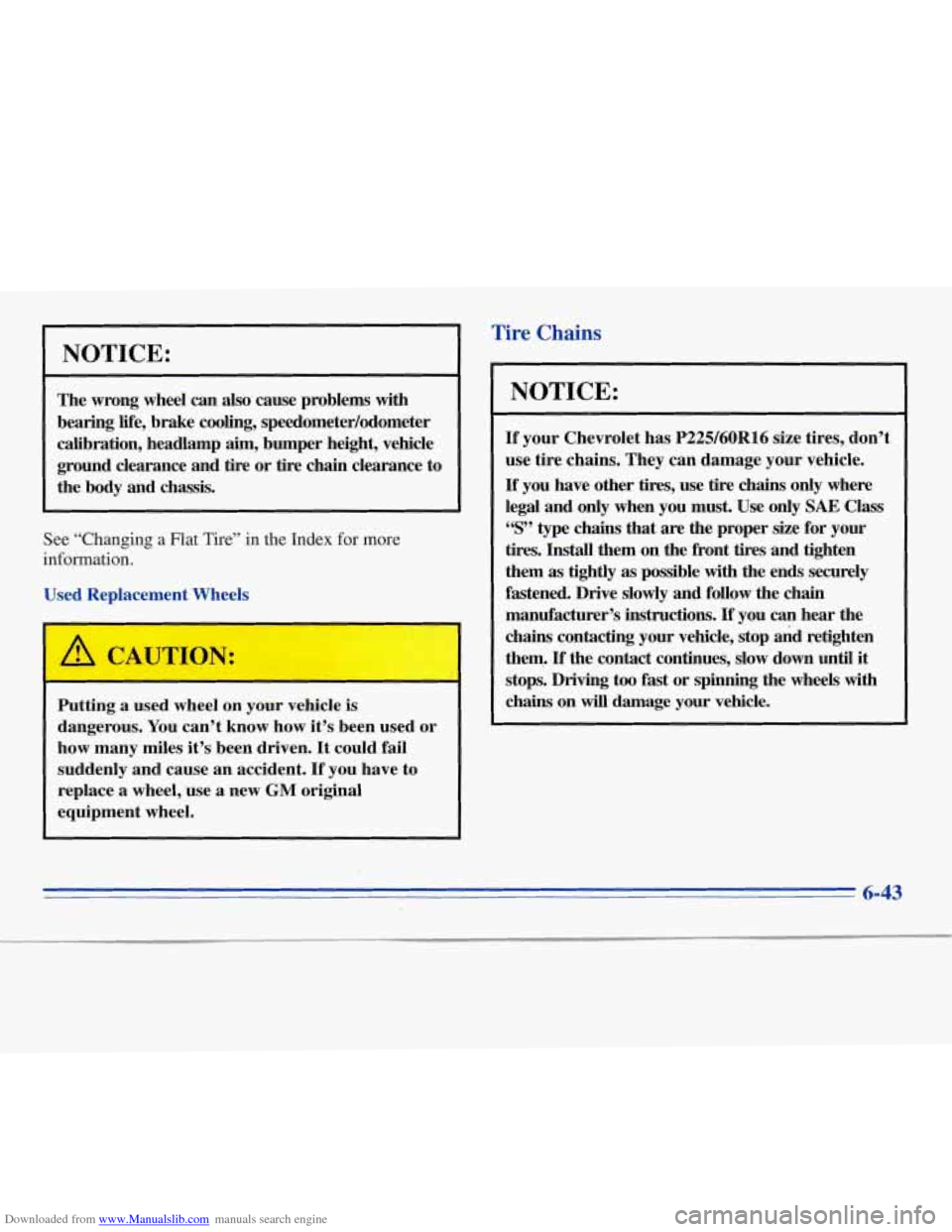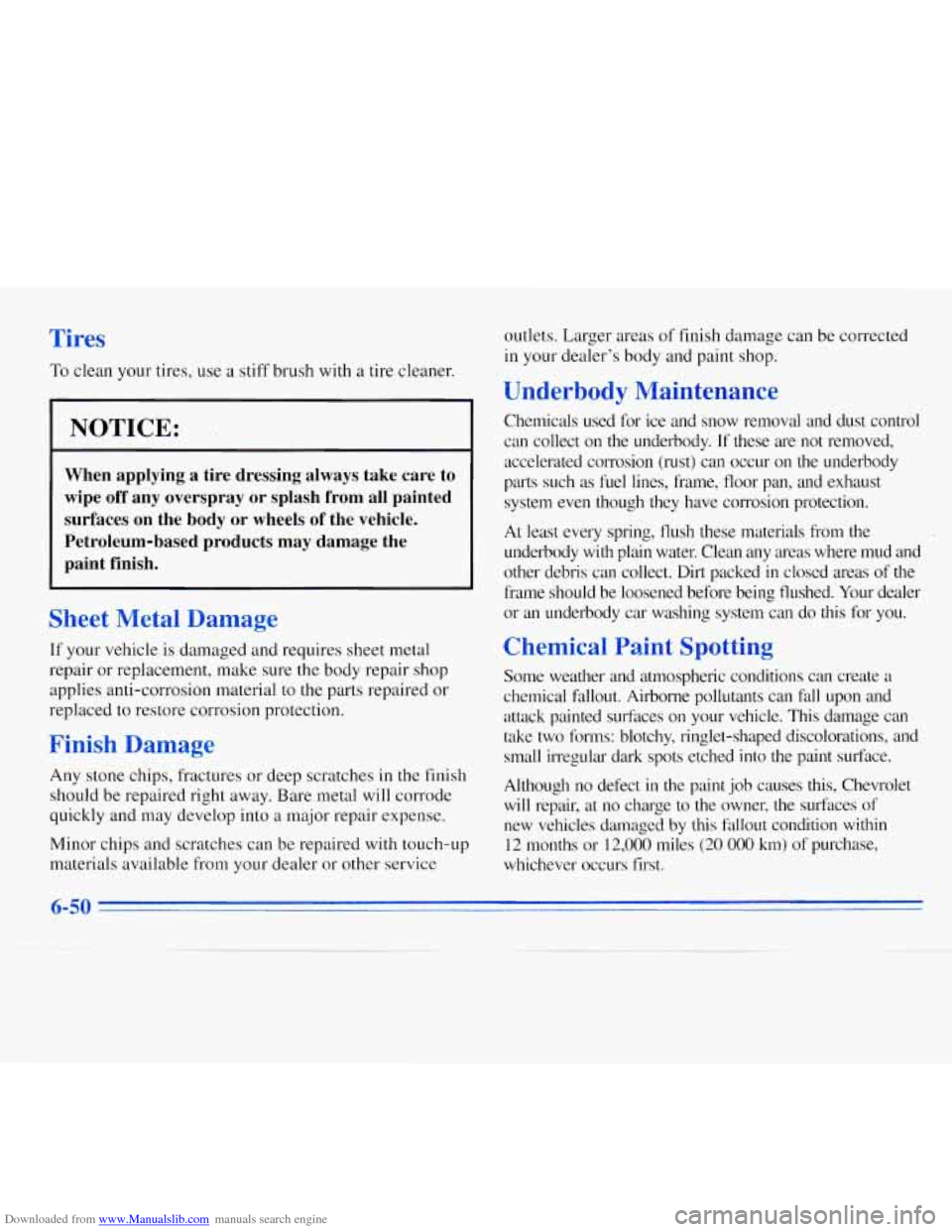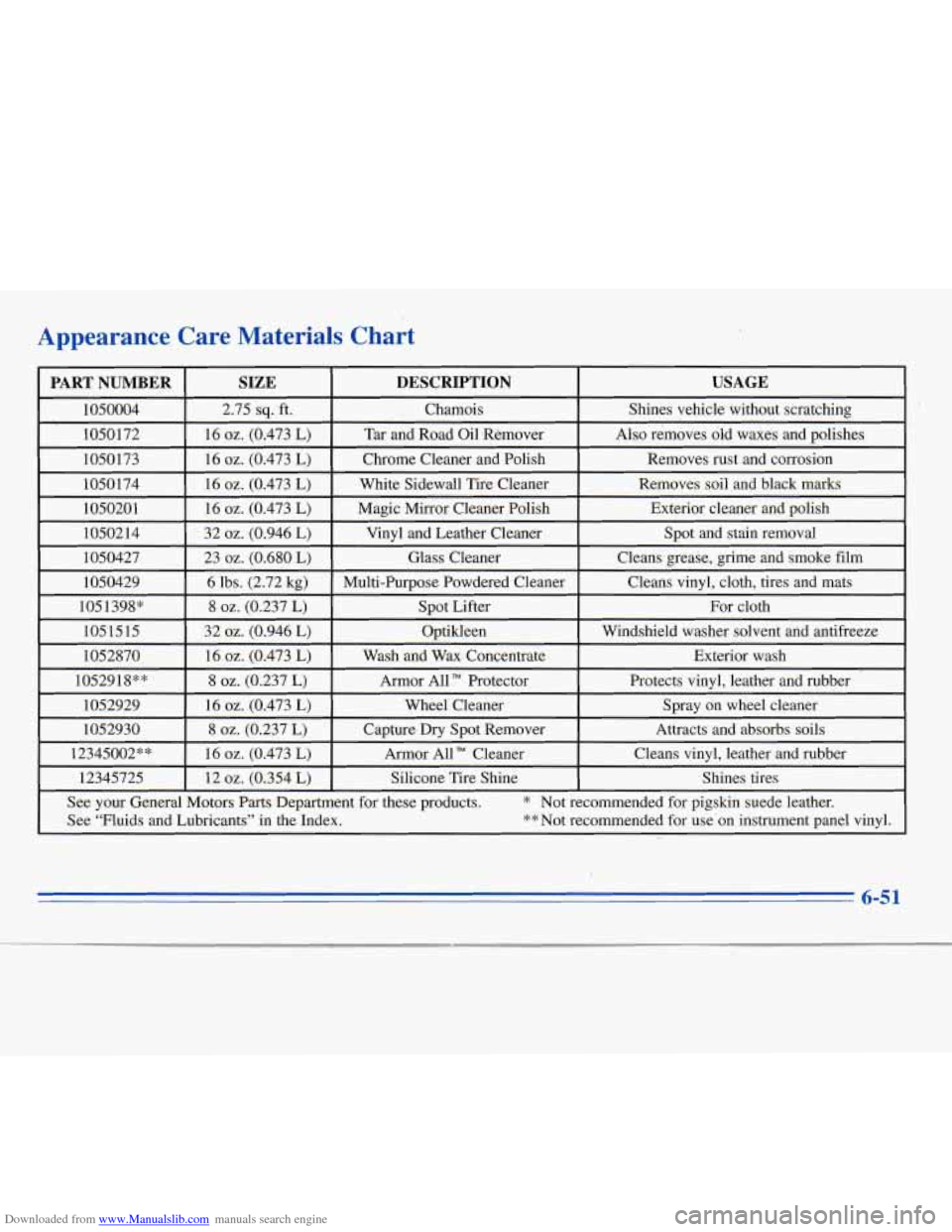1996 CHEVROLET MONTE CARLO tires
[x] Cancel search: tiresPage 246 of 340

Downloaded from www.Manualslib.com manuals search engine When to Check
Check your tires once a month or more.
Don’t forget your compact spare tire. It should be at
60 psi (420 kPa).
How to Check
Use a good quality pocket-type gage to check tire
pressure. You can’t tell if your tires are properly inflated
simply by looking at them. Radial tires may look
properly ‘inflated
even when they’re underinflated.
Be sure to put the valve caps back
on the valve stems.
They help prevent leaks by keeping out dirt and moisture.
Tire Inspection and Rotation
Tires should be inspected every 6,000 to 8,000 miles
(10 000 to 13 000 km) for any signs of unusual wear.
If unusual wear is present, rotate your tires as soon as
possible and check wheel alignment. Also check for
damaged tires
or wheels. See “When It’s Time for New
Tires’’ and “Wheel Replacement” later in this section for
more information. The purpose
of regular rotation
is to achieve more
uniform wear for
all tires on the vehicle. The kt
rotation is tlle most important. See “Scheduled
Maintenance Services”
in the Index for scheduled
rotation intervals.
Whcn rotating your tires,
always use the correct rotation
pattern
shown here.
Don’t include the compact spare tire
in your tire rotation.
u-30
Page 247 of 340

Downloaded from www.Manualslib.com manuals search engine After the tires have been rotated, adjust the front and
rear inflation pressures as shown on the Tire-Loading
Information label. Make certain that all wheel nuts are properly tightened. See “Wheel Nut Torque” in
I1 the Index.
I
When It’s Time for New Tires
(
Rust or dirt on a wheel, or on the parts to which
it is fastened, can make wheel nuts become loose
after
a time. The wheel could come off and cause
an accident. When you change a wheel, remove
any rust or
dirt from places where the wheel
attaches to the vehicle. In an emergency, you can
use a cloth or a paper towel to do this; but be
sure to use a scraper
or wire brush later, if you
need to, to get all the rust or dirt off. (See
‘(Changing
a Flat Tire? in the Index.)
One way to tell when it’s
time for new tires is to
check the treadwear indicators, which will appear when your tires have
only 1/16 inch (1.6
mm) or
less of tread remaining.
You need a new tire if any of the following statements
are true:
You can see the indicators at three or more places
around the tire.
You can see cord or fabric showing through the
tire’s rubber.
The tread or sidewall is cracked, cut or snagged deep
enough to show cord or fabric.
0 The tire has a bump, bulge or split.
The tire has a puncture, cut or other damage that
can’t be repaired well because of the size or location
of the damage.
6-39
Page 248 of 340

Downloaded from www.Manualslib.com manuals search engine Buying New Tires
To find out what kind and size of tires you need, look at
the Tire-Loading Information label.
The tires installed on your vehicle when
it was new had
a Tire Performance Criteria Specification (TPC Spec)
number on each ti.re’s sidewall. When
you get new tires,
~~ - -I - ~ 4
load range, speed rating and construction type (bias,
bias-belted or radial) as your original tires.
get ones
with that same
TPC Spec number. That way
your vehicle will continue to have tires that are designed
to give proper endurance, handling, speed rating,
traction, ride and other things during normal service on
your vehicle.
If your tires have an all-season tread
design, the TPC number will be followed by an
“MS”
(for mud and snow).
If you ever replace your tires with those not having a
TPC SDec number. make sure thev are the same size, Mixing tires could cause
you to lose control while
driving.
If you mix tires of different sizes or types
(radial and bias-belted tires), the vehicle may not
handle properly, and you could have a crash.
Using tires of different sizes may also cause
damage to your vehicle. Be sure to use the
same size and type tires on all four wheels.
It’s all right to drive with your compact spare,
though. It was developed for use on your vehicle.
Uniform Tire Quality Grading
The following information relates to the system developed
by the United States National Highway Traffic Safety
Administration, which grades tires by treadwear, &action
and temperature performance.
(This applies only to
vehicles sold in the United States.) The grades are molded on the sidewas
of most passenger car tires. The Uniform
Tire Quality Grading system does not apply to deep tread, winter-type snow tires, space-saver or temporary use spare
tires, tires
with nominal rim diameters of 10 to 12 inches
(25 to 30 cm), or to some limited-production tires.
Page 249 of 340

Downloaded from www.Manualslib.com manuals search engine While the tires available on General Motors passenger
cars and light trucks may vary with respect to these
grades,
they must also conform to Federal safety
requirements and additional General Motors Tire
Performance Criteria‘(TPC) standards.
Tread wear
The treadwear grade is a comparative rating based on
the wear rate of the tire when tested under controlled
conditions on
a specified government test course. For
example,
a tire graded 150 would wear one and a half
( I 1/2) times as well on the government course as a tire
graded
100. The relative performance of tires depends
upon the actual conditions of their use, however, and
may depart significantly from the norm due to variations
in driving habits, service practices and differences in
road characteristics and climate.
Traction - A, B, C
The traction grades, from highest to lowest, are A, B, and
C, and they represent the tire’s ability to stop on wet
pavement
as measured under controlled conditions on
specified government test surfaces
of asphalt and concrete.
A tire marked C may have poor traction performance. Warning:
The traction grade assigned to this tire
is based
on braking (straightahead) traction tests and does not
include cornering (turning) traction.
Temperature - A, B, C
The temperature grades are A (the highest), B, and C,
representing the tire’s resistance to the generation of
heat and its ability to dissipate heat when tested under
controlled conditions on a specified indoor laboratory
test wheel. Sustained high temperature can cause the
material of the tire to degenerate and reduce tire life,
and excessive temperature can lead to sudden tire
failure. The grade C corresponds to
a level of
performance which all passenger car tires must meet
under
the Federal Motor Vehicle Safety Standard
No. 109. Grades B and A represent higher levels of
performance on
the laboratory test wheel than the
minimum required by law.
Warning: The temperature grade for
this tire is
established for a tire that is properly inflated and not
overloaded. Excessive speed, underinflation, or
excessive loading, either separately or in combination,
can cause heat buildup and possible tire failure.
Page 250 of 340

Downloaded from www.Manualslib.com manuals search engine Wheel Alignment and Tire Balance
The wheels on your vehicle were aligned and balanced
carefully at the factory to give you the longest tire life
and best overall performance.
In most cases, you will not need to have your wheels
aligned again. However, if you notice unusual tire wear
or your vehicle pulling one way or the other, the
alignment may need to be reset. If you notice your
vehicle vibrating when driving
on a smooth road, your
wheels may need
to be rebalanced.
Wheel Replacement
Replace any wheel that is bent, cracked, or badly rusted
or corroded. If wheel nuts keep coming loose, the wheel,
wheel bolts and wheel nuts should be replaced. If the
wheel leaks air, replace it (except some aluminum
wheels, which can sometimes be repaired). See your
Chevrolet dealer if any of these conditions exist.
Your dealer will know the kind of wheel you need. Each
new wheel should have the same load carrying
capacity, diameter, width, offset and be mounted the
same way as the one
it replaces.
If you need to replace any of your wheels, wheel bolts
or wheel nuts, replace them only with new
GM original
equipment parts. This
way, you will be sure to have the
right wheel, wheel bolts and wheel nuts for your
Chevrolet model.
CAUTION:
Using the wrong replacement wheels, wheel bolts
or wheel nuts on your vehicle can be dangerous.
It could affect the braking and handling
of your
vehicle, make your tires lose air and make you
lose control.
You could have a collision in which
you or others could be injured. Always use
the correct wheel, wheel bolts and wheel nuts
for replacement.
6-42
Page 251 of 340

Downloaded from www.Manualslib.com manuals search engine NOTICE:
The wrong wheel can also cause problems with
bearing life, brake cooling, speedometer/odometer
calibration, headlamp aim, bumper height, vehicle
ground clearance and
tire or tire chain clearance to
,the body and chassis.
I I
See “Changing a Flat Tire” in the Index for more
information.
Used Replacement Wheels,
Tire Chains
Putting a used wheel on your vehicle is
dangerous.
You can’t know how it’s been used or
how many miles it’s been driven.
It could fail
suddenly and cause an accident.
If you have to
replace a wheel, use
a new GM original
equipment wheel.
NOTICE:
If your Chevrolet has P22960Rl6 size tires, don’t
use tire chains. They can damage your vehicle.
If you have other tires, use tire chains only where
legal and only when you must. Use only
SAE Class
“S” type chains that are the proper size for your
tires.
Install them on the front tires and tighten
them as tightly as possible with the ends securely
fastened. Drive slowly and follow the chain
manufacturer’s instructions.
If you can hear the
chains contacting your vehicle, stop
&d retighten
them.
If the contact continues, slow down until it
stops. Driving too fast or spinning the wheels with
chains on
will damage your vehicle.
6-43
Page 258 of 340

Downloaded from www.Manualslib.com manuals search engine Tires
To clean your tires, use a stiff brush with a tire cleaner.
NOTICE:
When applying a tire dressing always take care to
wipe off any overspray or splash from
all painted
surfaces on the body or wheels
of the vehicle.
Petroleum-based products may damage the
paint finish.
Sheet Metal Damage
If your vehicle is damaged and requires sheet metal
repair or replacement, make sure the body repair shop
applies anti-corrosion material to
the parts repaired or
replaced to restore corrosion protection.
Finish Damage
Any stone chips, fractures or deep scratches in the finish
should be repaired right away. Bare metal will corrode
quickly and may develop into
a major repair expense.
Minor chips and scratches can be repaired with touch-up
materials available from your dealer or other service outlets.
Larger areas of finish damage can be corrected
in your dealer’s body and paint shop.
Underbody Maintenance
Chemicals used for ice and snow removal and dust control
can collect on the underbody. If these are not removed,
accelerated corrosion (lust) can occur on the underbody
parts such as fuel lines, frame, floor pan, and exhaust system even though they have corrosion protection.
At least every spring, flush these materials from the
underbody with plain water. Clean
any areas where mud and
other debris can collect. Dirt packed
in closed areas of the
frame should be loosened before being flushed. Your dealer
or an underbody car washing system can do this for you.
Chemical Paint Spatting
Some weather and atmospheric conditions can create a
chemical fallout. Airborne pollutants can
fdl upon and
attack painted surfaces
on your vehicle. This damage can
take
two forms: blotchy, ringlet-shaped discolorations, and
small irregular dark spots etched into the paint surface.
Although no defect
in the paint job causes this, Chevrolet
will repair, at no charge to the owner, the surfaces of
new vehicles damaged by this fallout condition within
I2 months or 12,000 miles (20 000 kin) of purchase,
whichever occurs first.
6-50
Page 259 of 340

Downloaded from www.Manualslib.com manuals search engine Appearance Care Materia
PART NUMBER SIZE
1050004 16
oz. (0.473 L) 1050172 2.75
sq. ft.
32
02. (0.946 L) 1051515 8
02. (0.237 L) 105
1398"
6 lbs. (2.72 kg)
1050429 23
oz. (0.680
L)
1050427 32
oz. (0.946 L) 1050214 16
02. (0.473
L)
1050201 16
oz. (0.473
L)
1050174 16
oz. (0.473 L)
1050173
s Chart
1052870
8
oz. (0.237 L)
1052930 16
oz. (0.473 L)
1052929 8
oz. (0.237
L)
1052918** 16
oz. (0.473
L)
12345002"" 16
oz. (0.473 L)
DESCRIPTION USAGE
Chamois
Shines vehicle without scratching
Tar and Road Oil Remover
Spot and stain removal
Vinyl and Leather Cleaner Exterior cleaner
and polish
Magic Mirror Cleaner Polish Removes soil
and black marks
White Sidewall Tife Cleaner Removes
rust and corrosion
Chrome Cleaner and Polish Also
removes old waxes and polishes
Glass 'Cleaner
Cleans grease, grime and smoke film
Multi-Purpose Powdered Cleaner
Windshield washer solvent and antifreeze
Optikleen For
cloth
Spot Lifter Cleans vinyl, cloth,
tires and mats
Wash and Wax Concentrate Exterior wash
Armor All Protector
Spray on wheel cleaner
Wheel Cleaner Protects vinyl, leather
and rubber
Capture Dry Spot Remover Attracts and absorbs soils
Armor All Cleaner Cleans vinyl, leather
and rubber
Silicone Tire Shine Shines tires I I
12345725 I 12 oz. (0.354 L) I I
See
your General Motors Parts Department for these products. * Not recommended for pigskin suede leather.
I See "Fluids and Lubricants" in the-Index.
-
**Not recommended for use'on instrument panel vinyl. I
I ''
I
I 6-51